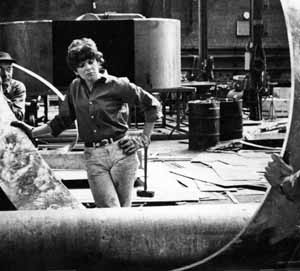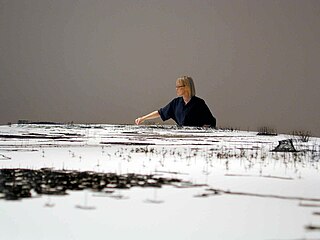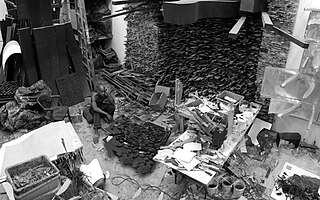
Cal Lane (born 1968) is a Canadian sculptor, known for creating delicate, lacy sculptures out of industrial steel products.

Cal Lane (born 1968) is a Canadian sculptor, known for creating delicate, lacy sculptures out of industrial steel products.
Lane was born in Halifax, Nova Scotia in 1968 [1] and raised on Vancouver Island, where she trained as a hairdresser and a welder. [2] She has a bachelor's degree from the Nova Scotia College of Art and Design and a Master of Fine Arts from the State University of New York at Purchase. [3]
Cal Lane uses a plasma cutter or an oxy-acetylene torch to cut intricate patterns into industrial steel products. [4]
Lane's work is often described in terms of dichotomy or contrast. Fred A. Bernstein wrote in The New York Times: "The work is about the contrasts between the industrial and the fanciful, the opaque and the transparent." [2] Writing for Sculpture magazine, Robin Peck said: "The dialectic is obvious: industrial versus domestic, strong versus delicate, masculine versus feminine, functional versus decorative." [5] Lori Zimmer wrote: "Lane enjoys pushing the dichotomy of feminine and masculine by combining patterns of domesticity with these cold, harsh symbols of masculine blue collar labor." [6]

Fiber art refers to fine art whose material consists of natural or synthetic fiber and other components, such as fabric or yarn. It focuses on the materials and on the manual labor on the part of the artist as part of the works' significance, and prioritizes aesthetic value over utility.

The Beaverbrook Art Gallery commonly referred to simply as The Beaverbrook, is a public art gallery in Fredericton, New Brunswick, Canada. It is named after William Maxwell "Max" Aitken, Lord Beaverbrook, who funded the building of the gallery and assembled the original collection. It opened in 1959 with over 300 works, including paintings by J. M. W. Turner and Salvador Dalí. The Beaverbrook Art Gallery is New Brunswick's officially designated provincial art gallery.

The DeCordova Sculpture Park and Museum is a sculpture park and contemporary art museum on the southern shore of Flint's Pond in Lincoln, Massachusetts, 20 miles northwest of Boston. It was established in 1950, and is the largest park of its kind in New England, encompassing 30 acres.

Ghada Amer is a contemporary artist, much of her work deals with issues of gender and sexuality. Her most notable body of work involves highly layered embroidered paintings of women's bodies referencing pornographic imagery.
Philip Grausman is an American sculptor, known for his portrait works.

Beverly Pepper was an American sculptor known for her monumental works, site specific and land art. She remained independent from any particular art movement. She lived in Italy, primarily in Todi, since the 1950s.

The Mildred Lane Kemper Art Museum is an art museum located on the campus of Washington University in St. Louis, within the university's Sam Fox School of Design & Visual Arts. Founded in 1881 as the St. Louis School and Museum of Fine Arts, it was initially located in downtown St. Louis. It is the oldest art museum west of the Mississippi River. The Museum holds 19th-, 20th-, and 21st-century European and American paintings, sculptures, prints, installations, and photographs. The collection also includes some Egyptian and Greek antiquities and Old Master prints.
Judith Brown was an American dancer and a sculptor who was drawn to images of the body in motion and its effect on the cloth surrounding it. She welded crushed automobile scrap metal into energetic moving torsos, horses, and flying draperies. "One of the things that made Judy stand out as an artist was her ability to work in many different mediums. Some of this was by choice, and sometimes it was by necessity. Her surroundings often dictated what medium she could work with at any given time. After all, you can't bring you're welding gear with you to Rome."
Holly Hotchner is the former president and CEO of the National Women's History Museum.

Anne Wilson is a Chicago-based visual artist. Wilson creates sculpture, drawings, Internet projects, photography, performance, and DVD stop motion animations employing table linens, bed sheets, human hair, lace, thread and wire. Her work extends the traditional processes of fiber art to other media. Wilson is a professor in the Department of Fiber and Material Studies at The School of the Art Institute of Chicago.
Viktor Mitic is a Serbian-born Canadian painter and sculptor living in Toronto, Ontario. He is best known for incorporating firearms in his art, a skill he acquired during national service in his native Yugoslavia. Because art and violence coexist in an inexplicable way, Mitic says his art highlights the absurdity and senselessness of gun violence, but at the same time he transforms these acts into art. One of his most notable works, the Blasted Beaverbrook, was commissioned for exhibition in 2009 by New Brunswick's provincial gallery, the Beaverbrook Art Gallery.

Alyson Shotz is an American sculptor based in Brooklyn, New York. She is known for experiential, large-scale abstract sculptures and installations inspired by nature and scientific concepts, which manipulate light, shadow, space and gravity in order to investigate and complicate perception. Writers suggest her work challenges tenets of monumental, minimalist sculpture—traditionally welded, solid, heavy and static—through its accumulation of common materials in constructions that are often flexible, translucent, reflective, seemingly weightless, and responsive to changing conditions and basic forces. Sculpture critic Lilly Wei wrote, "In Shotz’s realizations, the definition of sculpture becomes increasingly expansive—each project, often in series, testing another proposition, another possibility, another permutation, while ignoring conventional boundaries."
Linda Fleming is an American sculptor and university professor. She is currently teaches at California College of the Arts (CCA). She lives and works in Benicia, California, as well as maintaining studios and homes in the Smoke Creek Desert in Nevada, and in Libre, Colorado.
Rona Pondick is an American sculptor. She lives and works in New York City. Using the language of the body in her sculpture, in both a literal and a metaphorical sense, has been of interest to Pondick since the beginnings of her career in 1977. An abiding concern of hers has been the exploration of the use of different materials, a consistent motif that runs throughout her work from its beginnings to the present day.

Nancy Davidson is an American artist best known for large-scale inflatable sculptures regarded as hyper-feminized abstractions of the human female form. Bulbous and flesh-like, the sculptures resemble buttocks and breasts and employ erotic cultural signifiers in their shape and decoration. Davidson's work spans art media but centers around sculpture. It is largely post-minimal in character and described by commentators as providing a feminist counterpoint to the male-dominated, minimalist sculpture of the 1960s, as well as to cultural tropes involving bodies that the works themselves invoke. Of particular note are Davidson's use of humor and a sense of absurdity to seemingly both celebrate and subvert these tropes, inviting their investigation but without the seriousness and moralism that often accompany critical works. Sculpture Magazine critic Robert Raczka wrote that "The confectionary color and oversize scale" of Davidson's sculpture creates a "playfully upbeat mood that allows feminist and gender issues to rise to the surface at irregular intervals, without didacticism." The New Art Examiner's Susan Canning described it as establishing "a context where all can revel in the transgressive and liberating power of the grotesque."

Dave Cole is an American contemporary visual artist specializing in sculpture.

Leonardo Drew is a contemporary artist based in Brooklyn, New York. He creates sculptures from natural materials and through processes of oxidation, burning, and decay, Drew transforms these objects into massive sculptures that critique social injustices and the cyclical nature of existence.
Laylah Ali (born 1968) is an American contemporary visual artist. She is known for paintings in which ambiguous race relations are depicted with a graphic clarity and cartoon strip format. She lives in Williamstown, Massachusetts, and is a professor at Williams College.
Cat Mazza is an American textile artist. Her practice combines tactical media, activism, craft-based art making and animation in a form that has frequently been described as craftivism. She is the founder of the craftivist collective microRevolt. Mazza is an associate professor of art at the University of Massachusetts Boston.

Elana Herzog is an American installation artist and sculptor based in New York City. She is most known for abstract, tactile works in which she disassembles, reconfigures and embeds second-hand textiles in walls, modular panels and architectural spaces with industrial-grade metal staples. Herzog has been recognized with a Guggenheim Fellowship, Anonymous Was a Woman Award and Louis Comfort Tiffany Foundation Award, among others. She has exhibited nationally and internationally, including at the Brooklyn Museum, Museum of Arts and Design (MAD), Tang Museum, Weatherspoon Art Museum, Sharjah Art Museum, and Reykjavik Art Museum.
{{cite book}}: CS1 maint: multiple names: authors list (link)